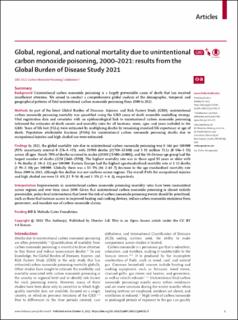Global, regional, and national mortality due to unintentional carbon monoxide poisoning, 2000–2021: results from the Global Burden of Disease Study 2021
Moberg, Madeline E; Hamilton, Erin B.; Zeng, Scott M; Carbon Monoxide Poisoning Collaboraton, GBD 2021; Bryazka, Dana; Zhao, Jeff T; Feldman, Rachel; Abate, Yohannes Habtegiorgis; Abbasi-Kangevari, Mohsen; Abdurehman, Ame Mehadi; Abedi, Aidin; Abu-Gharbieh, Eman; Addo, Isaac Yeboah; Adepoju, Abiola Victor; Adnani, Qorinah Estiningtyas Sakilah; Afzal, Saira; Ahinkorah, Bright Opoku; Ahmad, Sajjad; Ahmed, Danial; Ahmed, Haroon; Alem, Dejene Tsegaye; Al-Gheethi, Adel Ali Saeed; Alimohamadi, Yousef; Ameyaw, Edward Kwabena; Amrollahi-Sharifabadi, Mohammad; Anagaw, Tadele Fentabil; Anyasodor, Anayochukwu Edward; Arabloo, Jalal; Aravkin, Aleksandr Y; Athari, Seyyed Shamsadin; Atreya, Alok; Jafari, Amirhossein Azari; Badiye, Ashish D; Baghcheghi, Nayereh; Bagherieh, Sara; Bansal, Hansi; Barrow, Amadou; Bashiri, Azadeh; Bayileyegn, Nebiyou Simegnew; Berhie, Alemshet Yirga; Bhagavathula, Akshaya Srikanth; Bhardwaj, Pankaj; Boloor, Archith; Cámera, Luis Alberto; Carvalho, Felix; Carvalho, Márcia; Chandrasekar, Eeshwar K; Chang, Jung-Chen; Kisa, Adnan; Dadras, Omid; Fatima, Syeda Anum Fatima
Peer reviewed, Journal article
Published version
Permanent lenke
https://hdl.handle.net/11250/3106952Utgivelsesdato
2023Metadata
Vis full innførselSammendrag
Background
Unintentional carbon monoxide poisoning is a largely preventable cause of death that has received insufficient attention. We aimed to conduct a comprehensive global analysis of the demographic, temporal, and geographical patterns of fatal unintentional carbon monoxide poisoning from 2000 to 2021.
Methods
As part of the latest Global Burden of Diseases, Injuries, and Risk Factors Study (GBD), unintentional carbon monoxide poisoning mortality was quantified using the GBD cause of death ensemble modelling strategy. Vital registration data and covariates with an epidemiological link to unintentional carbon monoxide poisoning informed the estimates of death counts and mortality rates for all locations, sexes, ages, and years included in the GBD. Years of life lost (YLLs) were estimated by multiplying deaths by remaining standard life expectancy at age of death. Population attributable fractions (PAFs) for unintentional carbon monoxide poisoning deaths due to occupational injuries and high alcohol use were estimated.
Findings
In 2021, the global mortality rate due to unintentional carbon monoxide poisoning was 0·366 per 100 000 (95% uncertainty interval 0·276–0·415), with 28 900 deaths (21 700–32 800) and 1·18 million YLLs (0·886–1·35) across all ages. Nearly 70% of deaths occurred in males (20 100 [15 800–24 000]), and the 50–54-year age group had the largest number of deaths (2210 [1660–2590]). The highest mortality rate was in those aged 85 years or older with 1·96 deaths (1·38–2·32) per 100 000. Eastern Europe had the highest age-standardised mortality rate at 2·12 deaths (1·98–2·30) per 100 000. Globally, there was a 53·5% (46·2–63·7) decrease in the age-standardised mortality rate from 2000 to 2021, although this decline was not uniform across regions. The overall PAFs for occupational injuries and high alcohol use were 13·6% (11·9–16·0) and 3·5% (1·4–6·2), respectively.
Interpretation
Improvements in unintentional carbon monoxide poisoning mortality rates have been inconsistent across regions and over time since 2000. Given that unintentional carbon monoxide poisoning is almost entirely preventable, policy-level interventions that lower the risk of carbon monoxide poisoning events should be prioritised, such as those that increase access to improved heating and cooking devices, reduce carbon monoxide emissions from generators, and mandate use of carbon monoxide alarms.

